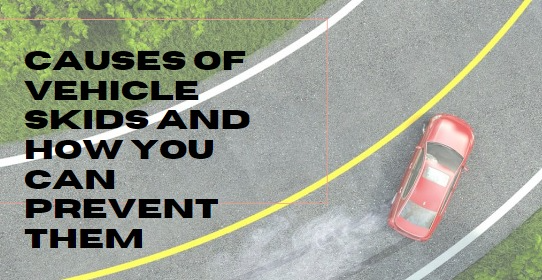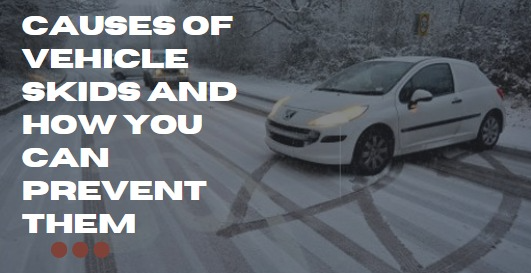Causes of Vehicle Skids and How You Can Prevent Them
A vehicle skid is a very dangerous situation. It can lead to loss of life, bodily injury, and irreparable damage to your car. What are the causes of vehicle skids and how can they be prevented? Find out below.
When the road or surface is slippery, it can result in friction between your tires and the road. This loss of traction is what is referred to as a car skid.
While a car skid can only occur on a slippery or wet road surface, there are many causes for it. In this article, we will be addressing this as well as preventive measures to ensure you avoid this vehicular problem.

Causes of Vehicle Skids
There are five major causes of vehicle skids. They include:
Wet or Icy Road surfaces
Wet, frosty, or icy road surfaces are popular causes of vehicle skids. During winter or rainy conditions, the road surfaces remain wet. Due to this accumulation of wetness, it can be challenging for tires to have traction or grip. This poor friction can result in vehicular skids. You have to pay attention when driving your car in these conditions. It may help if you drive slowly and keep a space between your vehicle and the one ahead of you.
Tires in poor condition
It is never good when you have balding or worn-out tires. A sign of this is when the tires have little or no tread left. This low tread depth can result in a loss of traction or grip on road surfaces, making vehicle skidding more likely to occur. Thus, you have to inspect your tires and change them when you notice they are balding.
Speeding
Another common cause of vehicle skids is speeding. When you drive at a fast speed, it becomes harder to control your vehicle. This is dangerous, especially when the road surface is icy or wet. To prevent this from happening, you have to stick to legally permitted speed limits and drive slowly in extreme climatic conditions.
Braking
Skids usually occur as a result of braking. When you apply sudden, extreme force to your brake pedal, your vehicle can lose control and skid. You should never hit your brakes with sudden force. Gentle braking is very important. This will reduce your chances of crashing, especially on slippery surfaces.
Mechanical Issue
Finally, if your vehicle has issues with its wheel cylinders, brake shoes, brake drum, steering wheel, shaft, rack, and pinion, it can lead to skidding. We recommend that you consult a mechanic if you experience strange vibrations or hear rattling sounds while driving your vehicle.
How to prevent vehicle skidding
This section explores ways you can prevent your vehicle from skidding:
Inspect your tires
You have to always inspect your tires. This way, you can make sure the tire tread and pressure is working excellently. Good tires equate to better control on the road.
Slow Down
One of the causes of skidding is over-speeding. When you speed your vehicle on a frosty or wet road surface, it is more likely to skid. This is because there is low friction between tires and the road surface in that condition. So, you have to drive slowly in wet conditions, particularly in extreme weather.
Also, skidding can likely occur when you approach a bend or curve. Be sure to reduce your vehicle speed when you drive around roads with twists, bends, or curves.
Be Watchful
If you are driving on a road with wet or frosty surfaces, pay close attention to your driving. Put away distractions like loud music and focus on your steering wheel.
Prevent Sharp Wheel Turns
When you move the wheel abruptly to either side, it can also result in skidding. Thus, with gentle driving, you can lower the likelihood of skidding. For instance, you have to drive near the centerline when you are on a bend or curving road.
What to do when your vehicle skids
Skidding may not necessarily end up in an accident. There are ways you can manage the skid and maneuver your vehicle. You have to take timely steps. Here are things you can do when your vehicle skids to reduce the possibility of an accident occurring:
Take your feet off the gas pedal
Do not hit the gas pedal as your vehicle skids. This will worsen an already bad situation and increase the risk of a crash. Take your feet off the gas pedal totally.
Don’t Brake
When a skid happens, you may be tempted to hit the brake. But this will complicate matters and increase the chances of an accident. If it is necessary to hit the brake, avoid applying force.
Drive to the Skid’s Direction
If you find yourself in a skid, never steer in the opposite direction. It won’t solve the problem. It may even cause you to lose control of your car and result in a crash.
What you have to do is drive gently in a parallel direction with the skid. This will allow you to maintain control of your vehicle. Then, begin to steer the wheel in a straight motion till you regain control of your vehicle.
That is it on Causes of Vehicle Skids and How You Can Prevent Them. Check below for other related articles.
Recommended:
24-hour Vehicle Cameras to Capture Vandalism while Parked
Is My Bike UDH Compatible? How to check compatibility
